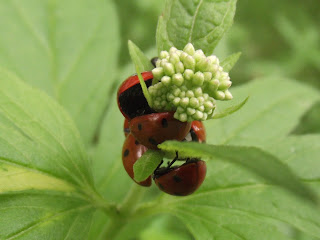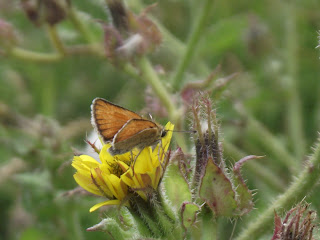Mid-November sees a break in lectures and this year the college laid on three field trips for those of us who were interested.
Monday was a visit to the Wildwood Trust in Kent to learn more about their captive breeding programmes. In particular their water vole programme. Water vole populations have declined over the years mainly die to loss of habitat and the alien species American Mink. The Trust often takes in voles which are part of a translocation programme. Depending on the length of time they are going to be in captivity they will breed from the animals to ensure their survival. As such it is often the grandchildren of the original animals which are released into the wild. In 2011 they bred approximately 270 voles there. We met "Betty" who was the first water vole I have ever seen in the "fur". We also had a wander round all the cages. It seems to be a very labour intensive process looking after all these voles but a worthwhile project to ensure their survival. The girl pictured with "Betty" is a Writtle graduate currently carrying out an internship with the Trust.
 |
| Introducing "Betty" |
 |
| One of the many enclosures housing the voles |
Following the voles, we were then guided round the rest of the park by a couple of members of the educational team. We were shown some small mammals such as pine marten but then moved on to the boar. it was interesting to see the effect they have on the ground in their enclosure as this would be what it would be like if they were released into the wild. Although they make a mess of the ground with their trampling and snuffling the disturbance can be good for many species. The one species it is not good for is the bluebell. The UK's bluebell woods are the finest examples in the world and boar in the wild could have a catastrophic impact on this.
 |
| "Harriet" the wild boar |
We also saw bison, wolves, lynx, Konik horses and some sleeping beavers. The red squirrels were adorable but they don't seem to do very well in captivity showing signs of stereotypies. This is where the animal behaves in a repetitive or habitual way, such as pacing along the enclosure boundary.
 |
| Konik Horse - another fashionable conservation tool |
 |
| European bison |
 |
| Wildwood Trust |
 |
| One of the red squirrels |
After lunch we drove to a Kent Wildlife Trust site called Ham Fen where they have released beavers into a secured area for conservation purposes. Surrounded by an electric fence the fen is exceptionally boggy, as you would expect, and there were obvious signs of beaver activity with some felled trees and some well-nibbled ones.
Further along the river we encountered exceptionally wet ground and in fact I ended up thigh-deep in a badger burrow. Covered in mud and with walking boots full of water I marched on (carefully) to see the beaver lodge and their dam. An impressive construction built in about a fortnight. They are truly amazing animals in terms of their engineering ability.
On Tuesday we headed out to the Dengie Peninsula (a Special Protection Area and an Area of Outstanding Natural Beauty); a place which inspired films such as War of the Worlds and The Birds due to it's other-worldly, bleak appearance, and somewhere I've wanted to go for some time. We were here to start the Big Birding Bash and we went to a few different sites including arable, coastal and estuarine. Our list of spots (few of which were identified by me!) included:
- Corn Bunting
- Chaffinch
- Goldfinch
- Carrion Crow
- Hooded Crow
- Magpie
- Skylark
- Reed Bunting
- Yellowhammer
- Brent Goose
- Oystercatcher
- Redshank
- Turnstone
- Marsh Harrier
- Little Egret
- Dunlin
- Shelduck
- Curlew
- Golden Plover
- Lapwing
- Mistle Thrush
- Little Owl (the most exciting for me!!)
 |
| Waiting for the owls to show... with some very eerie trees! |
Friday was the last day of the field trip programme and we headed off to Hertfordshire to attend a few talks by staff at Rothamsted Research. Having put a career in research into the melting pot of future ideas I was excited to be going there to find out what it was all about. The place felt very "sciencey" in an old-fashioned kind of way and these people really know what they are talking about. Specialists in aphids, bumblebees and long-term research projects it was fascinating to hear them talk. The focus is very much agricultural research; increasing productivity whilst developing environmentally sustainable solutions.
A trip to the ladies took me back a couple of decades to my Grandma's house when I spotted a little toilet roll doll on top of the hand dryer: fabulous. The staff canteen was pretty fantastic as well. Looks like a good place to work overall!
An excellent week of interesting field trips topped off by having to hand in 3 assignments in quick succession. Perhaps I should have stayed home to concentrate on those - only time will tell! I'm happy to trade a few marks for a sighting of a Little Owl.








































